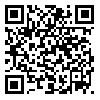BibTeX | RIS | EndNote | Medlars | ProCite | Reference Manager | RefWorks
Send citation to:
URL: http://shenakht.muk.ac.ir/article-1-2371-en.html
2- Associate professor of psychology, Department of psychology, Faculty of literature and human science Ilam University, Ilam – Iran. ,
3- Associate professor department of family counseling, Sanandaj branch, Islamic Azad University, Sanandaj, Iran.
Introduction: Emotion regulation plays a crucial role in improving interpersonal relationships, social adaptation, and fostering constructive communication. Given the increasing use of virtual environment by students, it appears that cyber violence has a detrimental effect on their emotion regulation.
Aim: The present study aimed to examine the impact of an empowerment package against cyber violence on the emotion regulation of high school students.
Method: This study used a sequential exploratory mixed-methods approach, consisting of qualitative and quantitative phases. In the qualitative phase, to develop the empowerment package against cyber violence, a needs-based inductive thematic analysis method was used. In the quantitative phase, a quasi-experimental pretest-posttest design with a control group and a two-month follow-up was conducted. The research population in the qualitative section included books and experts in the field of cyber violence, with a sample comprising 25 books and 10 specialists. In the quantitative phase, the statistical population included all high school students in Ilam during 2023-2024. The research sample consisted of 30 high school students selected through purposive sampling and randomly assigned to experimental and control groups. Participants completed the Gross and John (2003) Emotion Regulation Questionnaire at three time points: pretest, posttest, and follow-up. Data were analyzed using repeated measures ANOVA in SPSS 23 software.
Results: The results indicated that the empowerment package against cyber violence significantly affected the emotion regulation of high school students (P < 0.05). The effectiveness of this intervention persisted in the follow-up phase.
Conclusion: Training with the empowerment package against cyber violence improved students’ emotion regulation. Therefore, it is recommended that this package be utilized in designing effective interventions for regulating students’ emotions in the face of cyber violence
Received: 2024/10/18 | Accepted: 2024/11/19 | Published: 2025/08/11
| Rights and permissions | |
 |
This work is licensed under a Creative Commons Attribution-NonCommercial 4.0 International License. |


